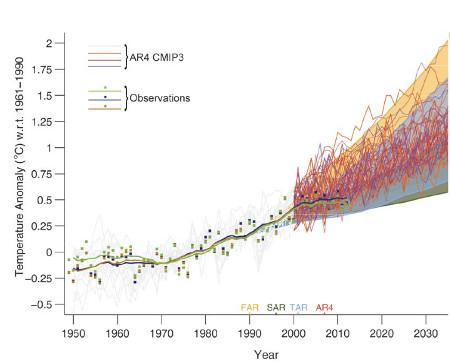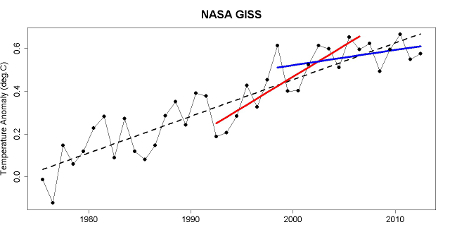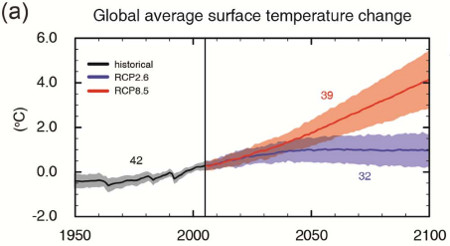The figure below from the 2013 Intergovernmental Panel on Climate Change (IPCC) report compares the global surface warming projections made in the 1990, 1995, 2001, and 2007 IPCC reports to the temperature measurements.

Enter a term in the search box to find its definition.
Use the controls in the far right panel to increase or decrease the number of terms automatically displayed (or to completely turn that feature off).
Home
 Arguments Arguments
 Software Software
 Resources
Comments Resources
Comments
 The Consensus Project The Consensus Project
 Translations Translations
 About
Support About
Support
|
||||

 Latest Posts
|
IPCC global surface warming projections have been accurateWhat the science says...Global surface temperature measurements fall within the range of IPCC projections. Climate Myth...IPCC global warming projections were wrong
The figure below from the 2013 Intergovernmental Panel on Climate Change (IPCC) report compares the global surface warming projections made in the 1990, 1995, 2001, and 2007 IPCC reports to the temperature measurements.  IPCC AR5 Figure 1.4. Solid lines and squares represent measured average global surface temperature changes by NASA (blue), NOAA (yellow), and the UK Hadley Centre (green). The colored shading shows the projected range of surface warming in the IPCC First Assessment Report (FAR; yellow), Second (SAR; green), Third (TAR; blue), and Fourth (AR4; red).
Since 1990, global surface temperatures have warmed at a rate of about 0.15°C per decade, within the range of model projections of about 0.10 to 0.35°C per decade. As the IPCC notes,
What about the Naysayers?In the weeks and months leading up to the publication of the final 2013 IPCC report, there has been a flood of opinion articles in blogs and the mainstream media claiming that the models used by the IPCC have dramatically over-predicted global warming and thus are a failure. This narrative clearly conflicts with the IPCC model-data comparison figure shown above, so what's going on? These mistaken climate contrarian articles have all suffered from some combination of the following errors. 1) Publicizing the flawed draft IPCC model-data comparison figureLate last year, an early draft of the IPCC report was leaked, including the first draft version of the figure shown above. The first version of the graph had some flaws, including a significant one immediately noted by statistician and climate blogger Tamino.
In the draft version of the IPCC figure, it was simply a visual illusion that the surface temperature data appeared to be warming less slowly than the model projections, even though the measured temperature trend fell within the range of model simulations. Obviously this mistake was subsequently corrected. This illustrates why it's a bad idea to publicize material in draft form, which by definition is a work in progress. 2) Ignoring the range of model simulationsA single model run simulates just one possible future climate outcome. In reality, there are an infinite number of possible outcomes, depending on how various factors like greenhouse gas emissions and natural climate variability change. This is why climate modelers don't make predictions; they make projections, which say in scenario 'x', the climate will change in 'y' fashion. The shaded regions in the IPCC figure represent the range of outcomes from all of these individual climate model simulations. The IPCC also illustrates the "multi-model mean," which averages together all of the individual model simulation runs. This average makes for an easy comparison with the observational data; however, there's no reason to believe the climate will follow that average path, especially in the short-term. If natural factors act to amplify human-caused global surface warming, as they did in the 1990s, the climate is likely to warm faster than the model average in the short-term. If natural factors act to dampen global surface warming, as they have in the 2000s, the climate is likely to warm more slowly than the model average. When many model simulations are averaged together, the random natural variability in the individual model runs cancel out, and the steady human-caused global warming trend remains left over. But in reality the climate behaves like a single model simulation run, not like the average of all model runs. This is why it's important to retain the shaded range of individual model runs. 3) Cherry PickingMost claims that the IPCC models have failed are based on surface temperature changes over the past 15 years (1998–2012). During that period, temperatures have risen about 50 percent more slowly than the multi-model average, but have remained within the range of individual model simulation runs. However, 1998 represented an abnormally hot year at the Earth's surface due to one of the strongest El Niño events of the 20th century. Thus it represents a poor choice of a starting date to analyze the surface warming trend (selectively choosing convenient start and/or end points is also known as 'cherry picking'). For example, we can select a different 15-year period, 1992–2006, and find a surface warming trend nearly 50 percent faster than the multi-model average, as statistician Tamino helpfully illustrates in the figure below.  Global surface temperature data 1975–2012 from NASA with a linear trend (black), with trends for 1992–2006 (red) and 1998–2012 (blue).
In short, if climate contrarians weren't declaring that global surface warming was accelerating out of control in 2006, then he has no business declaring that global surface warming has 'paused' in 2013. Both statements are equally wrong, based on cherry picking noisy short-term data. IPCC models have been accurateFor 1992–2006, the natural variability of the climate amplified human-caused global surface warming, while it dampened the surface warming for 1997–2012. Over the full period, the overall warming rate has remained within the range of IPCC model projections, as the 2013 IPCC report notes.
The IPCC also notes that climate models have accurately simulated trends in extreme cold and heat, large-scale precipitation pattern changes, and ocean heat content (where most global warming goes). Models also now better simulate the Arctic sea ice decline, which they had previously dramatically underestimated. All in all, the IPCC models do an impressive job accurately representing and projecting changes in the global climate, contrary to contrarian claims. In fact, the IPCC global surface warming projections have performed much better than predictions made by climate contrarians. It's important to remember that weather predictions and climate predictions are very different. It's harder to predict the weather further into the future. With climate predictions, it's short-term variability (like unpredictable ocean cycles) that makes predictions difficult. They actually do better predicting climate changes several decades into the future, during which time the short-term fluctuations average out. That's why climate models have a hard time predicting changes over 10–15 years, but do very well with predictions several decades into the future, as the IPCC illustrates. This is good news, because with climate change, it's these long-term changes we're worried about:  IPCC AR5 projected global average surface temperature changes in a high emissions scenario (RCP8.5; red) and low emissions scenario (RCP2.6; blue).
Intermediate rebuttal written by dana1981 Update July 2015: Here is a related lecture-video from Denial101x - Making Sense of Climate Science Denial Last updated on 9 July 2015 by pattimer. View Archives Printable Version | Offline PDF Version | Link to this page
Argument FeedbackPlease use this form to let us know about suggested updates to this rebuttal. CommentsComments 1 to 5: Post a CommentPolitical, off-topic or ad hominem comments will be deleted. Comments Policy... You need to be logged in to post a comment. Login via the left margin or if you're new, register here. |
|
THE ESCALATOR |
|
| © Copyright 2025 John Cook | ||||
| Home | Translations | About Us | Privacy | Contact Us | ||||
Nice work! It would even more convincing if the record temperatures of 2014, 2015, and 2016 were plotted.
I understand that the graph from the IPCC "is what it was" but it does not reflect the current temperature record and it is NOW being used to claim that the model projections were wrong.
Yes I know that anyone who believes that is being foolish but for those "skeptics" who actually refer to this site, such things can be weaponized. I suggest we keep the original and then show it with the current added in.
Bishop,
Thank you for your insightful comment. All the OP's on SkS are written by volunteers. You could write an updated OP and submit it. Be sure to cite where you get the updated data from.
I am very sorry I misspelled your handle Virgil.
My spell checker keeps changing your handle bjchip. Sorry.